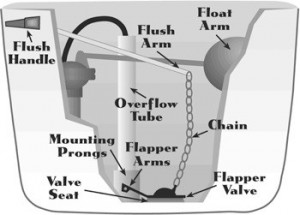While you’re carefully watching your water usage, it’s important to make sure that water is not slipping away due to undetected leaks in your system. Here’s a simple procedure that can tell you if you have a leak and how much water you’re losing.
- Locate your water meter. It is usually located near the street in front of your home.
- Read the meter twice – first at night after the day’s water use has ended, and again in the morning before any water is used.
- Subtract the first number from the second reading to tell how much water (if any) leaked out overnight.
- If you suspect a leak, your pipes and connections should be checked and repaired quickly.
The toilet is a common source of unnoticed leaks. Undetected, hundreds of gallons of water can be wasted each day. Often leaks occur when the toilet is out of adjustment or parts are worn. Listening carefully for the sound of running water is a good way to detect a possible leak. Food coloring or a dye tablet added to the tank will also reveal water leaking into the toilet bowl. Drop it in the tank and don’t flush. If the water in the bowl turns color, you have a leak.
If you suspect a leak and need assistance in determining its location, please call our local office.


